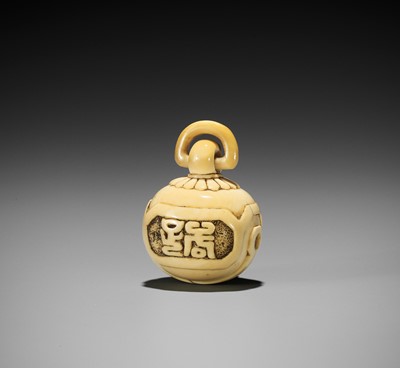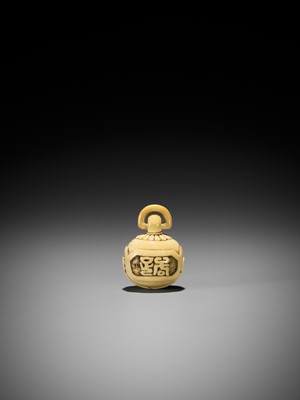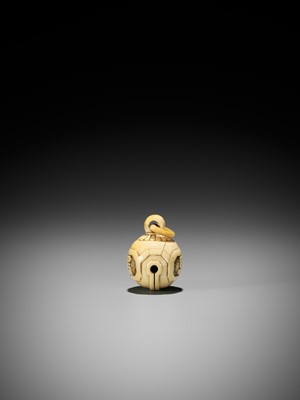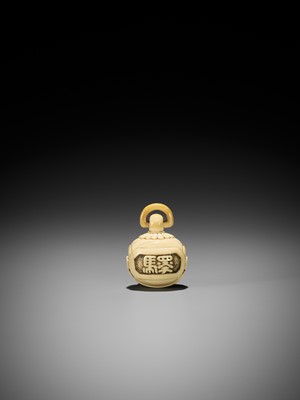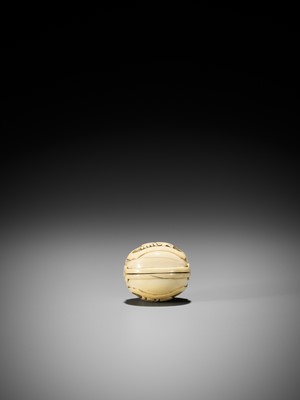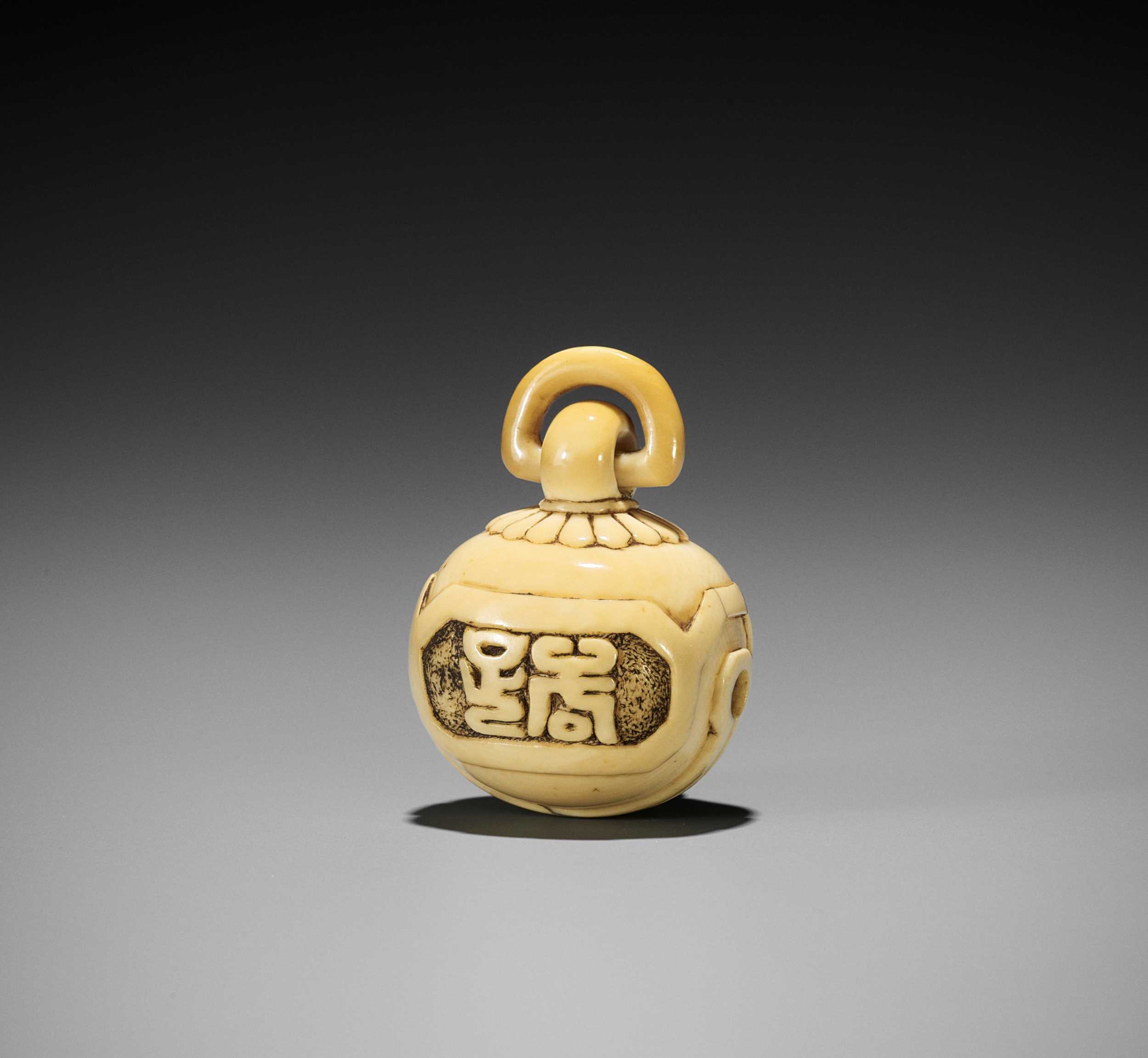27th May, 2022 13:00
Fine Japanese Art
254
Ɏ MASATOMO: A RARE IVORY NETSUKE OF A STATION BELL (EKIREI)
Sold for €1,011
including Buyer's Premium
By Masatomo, signed Masatomo
Japan, Kyoto, 18th century, Edo period (1615-1868)
The globular bell surmounted by a loop encircled by chrysanthemum petals and carved with a loose semi-circular handle, the sides carved with two shaped reverses, each enclosing the characters ekirei carved in relief against a stippled ground heightened with sumi. Signed below the chrysanthemum collar MASATOMO.
HEIGHT 4.5 cm
Condition: Very good condition with wear, minor age cracks. Fine and smooth honey patina.
Provenance: The Gabor Wilhelm Collection, Paris.
Under the Japanese ritsuryo system, station bells or post bells (ekirei) were bells of red copper issued by the central government or by local provincial government offices to travelling officials or messengers known as ekishi. Functioning as a proof of identity, they allowed them to procure horses and labor at post stations. Depending on the rank of the emissary, the bells were marked with a number of notches regulating the number of horses that could be requested. A prince of royal blood of first rank, for example, would receive ten horses. On urgent dispatches the ekishi would ride with the bells ringing in order to be able to change horses at any time of day or night without delay. These bells were also known as post road bells (ekiru no suzu) or stable bells (umaya no suzu). The system was established in the Taiho Code from 701 and was in use until the end of the 12th century or the end of the Heian period when it fell in disuse together with the demise of the centralized state.
Literature comparison:
A related ivory netsuke of a station bell, also carved with the ekirei characters in relief, but of different form, is illustrated by Davey, Neil K. (1974) Netsuke: A comprehensive study based on the M.T. Hindson Collection, p. 372, no. 1120.
Trade Certificate: The trade certificate for the sale of this lot within the EU has been granted (permit number AT 22-B-0291).
By Masatomo, signed Masatomo
Japan, Kyoto, 18th century, Edo period (1615-1868)
The globular bell surmounted by a loop encircled by chrysanthemum petals and carved with a loose semi-circular handle, the sides carved with two shaped reverses, each enclosing the characters ekirei carved in relief against a stippled ground heightened with sumi. Signed below the chrysanthemum collar MASATOMO.
HEIGHT 4.5 cm
Condition: Very good condition with wear, minor age cracks. Fine and smooth honey patina.
Provenance: The Gabor Wilhelm Collection, Paris.
Under the Japanese ritsuryo system, station bells or post bells (ekirei) were bells of red copper issued by the central government or by local provincial government offices to travelling officials or messengers known as ekishi. Functioning as a proof of identity, they allowed them to procure horses and labor at post stations. Depending on the rank of the emissary, the bells were marked with a number of notches regulating the number of horses that could be requested. A prince of royal blood of first rank, for example, would receive ten horses. On urgent dispatches the ekishi would ride with the bells ringing in order to be able to change horses at any time of day or night without delay. These bells were also known as post road bells (ekiru no suzu) or stable bells (umaya no suzu). The system was established in the Taiho Code from 701 and was in use until the end of the 12th century or the end of the Heian period when it fell in disuse together with the demise of the centralized state.
Literature comparison:
A related ivory netsuke of a station bell, also carved with the ekirei characters in relief, but of different form, is illustrated by Davey, Neil K. (1974) Netsuke: A comprehensive study based on the M.T. Hindson Collection, p. 372, no. 1120.
Trade Certificate: The trade certificate for the sale of this lot within the EU has been granted (permit number AT 22-B-0291).
Zacke Live Online Bidding
Our online bidding platform makes it easier than ever to bid in our auctions! When you bid through our website, you can take advantage of our premium buyer's terms without incurring any additional online bidding surcharges.
To bid live online, you'll need to create an online account. Once your account is created and your identity is verified, you can register to bid in an auction up to 12 hours before the auction begins.
Intended Spend and Bid Limits
When you register to bid in an online auction, you will need to share your intended maximum spending budget for the auction. We will then review your intended spend and set a bid limit for you. Once you have pre-registered for a live online auction, you can see your intended spend and bid limit by going to 'Account Settings' and clicking on 'Live Bidding Registrations'.
Your bid limit will be the maximum amount you can bid during the auction. Your bid limit is for the hammer price and is not affected by the buyer’s premium and VAT. For example, if you have a bid limit of €1,000 and place two winning bids for €300 and €200, then you will only be able to bid €500 for the rest of the auction. If you try to place a bid that is higher than €500, you will not be able to do so.
Online Absentee and Telephone Bids
You can now leave absentee and telephone bids on our website!
Absentee Bidding
Once you've created an account and your identity is verified, you can leave your absentee bid directly on the lot page. We will contact you when your bids have been confirmed.
Telephone Bidding
Once you've created an account and your identity is verified, you can leave telephone bids online. We will contact you when your bids have been confirmed.
Classic Absentee and Telephone Bidding Form
You can still submit absentee and telephone bids by email or fax if you prefer. Simply fill out the Absentee Bidding/Telephone bidding form and return it to us by email at office@zacke.at or by fax at +43 (1) 532 04 52 20. You can download the PDF from our Upcoming Auctions page.
How-To Guides
How to Create Your Personal Zacke Account
How to Register to Bid on Zacke Live
How to Leave Absentee Bids Online
How to Leave Telephone Bids Online
中文版本的操作指南
创建新账号
注册Zacke Live在线直播竞拍(免平台费)
缺席投标和电话投标
Third-Party Bidding
We partner with best-in-class third-party partners to make it easy for you to bid online in the channel of your choice. Please note that if you bid with one of our third-party online partners, then there will be a live bidding surcharge on top of your final purchase price. You can find all of our fees here. Here's a full list of our third-party partners:
- 51 Bid Live
- EpaiLive
- ArtFoxLive
- Invaluable
- LiveAuctioneers
- the-saleroom
- lot-tissimo
- Drouot
Please note that we place different auctions on different platforms. For example, in general, we only place Chinese art auctions on 51 Bid Live.
Bidding in Person
You must register to bid in person and will be assigned a paddle at the auction. Please contact us at office@zacke.at or +43 (1) 532 04 52 for the latest local health and safety guidelines.
